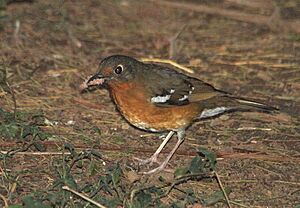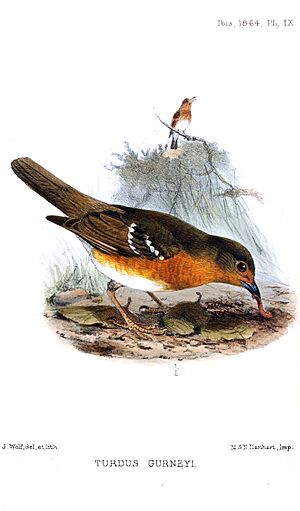Orange ground thrush facts for kids
Quick facts for kids Orange ground thrush |
|
|---|---|
 |
|
| Conservation status | |
| Scientific classification | |
| Genus: |
Geokichla
|
| Species: |
gurneyi
|
| Synonyms | |
|
Zoothera gurneyi |
|
The orange ground thrush (scientific name: Geokichla gurneyi) is a beautiful bird. It belongs to the thrush family, known as Turdidae. This bird is famous for its bright orange chest.
Contents
What is the Orange Ground Thrush?
A scientist named Hartlaub first described the orange ground thrush in 1864. He named it Turdus gurneyi at that time. The bird was named after John Henry Gurney Sr.. He was an English banker and a bird expert.
There are five different types, or subspecies, of the orange ground thrush. Each subspecies lives in a slightly different area. For example, one type lives in central Kenya. Another type is found in western Angola and nearby countries.
Where Does the Orange Ground Thrush Live?
The orange ground thrush lives in the mountains of southeastern Africa. Its home is called the afromontane forest. These are special forests found on African mountains.
This bird can be found in a very large area. Its habitat stretches over 5,370,000 square kilometers (about 2,073,000 square miles). You can find these birds at different heights. They live from 500 meters (1,640 feet) up to 2,500 meters (8,200 feet) high.
What Does the Orange Ground Thrush Look Like?
The orange ground thrush is a medium-sized bird. It is about 21 to 23 centimeters (8 to 9 inches) long. Male birds weigh between 44.5 and 64.5 grams (1.6 to 2.3 ounces). Females are a bit heavier, weighing 48.5 to 76 grams (1.7 to 2.7 ounces).
Its back and wings are olive-brown. Some parts might look a bit grey. The flight feathers are dark brown. You can see two bars on its wings. The throat, chest, and sides are a bright orange color. Its belly is white. There is also a white ring around its eye. The beak is dark, and its legs are pink. Female birds look like males but are not as brightly colored. Young birds have spotted patterns on their undersides.
Life and Habits of the Orange Ground Thrush
The orange ground thrush is most active during dawn and dusk. This means it is a crepuscular animal. It usually stays in one place. However, some birds move to different mountain heights depending on the season.
This bird makes a "tsip" or "cureek" sound. Its song is very pretty and melodious. It often looks for food on the ground. Its diet includes earthworms, insects, and molluscs like snails. They also eat fruits.
Reproduction and Life Cycle
The breeding season for these birds changes by location. In Kenya, they breed from January to May. In South Africa, it's from September to December. Female birds are often heavier than males during this time.
The nest is shaped like a deep cup. It is built from moss, small branches, leaves, roots, and ferns. The female lays 2 to 3 eggs. The eggs are a beautiful turquoise-blue color. The parents sit on the eggs for about 15 days. After hatching, the young birds stay in the nest for 18 to 20 days before they can fly.
What is the Orange Ground Thrush's Status?
We don't know exactly how many orange ground thrushes there are. Their numbers are going down because they are losing their homes. This is called habitat loss.
However, the IUCN Red List has listed this bird as "least concern." This means they are not in immediate danger. This is because they live in a very large area. Also, their population is not decreasing fast enough to be considered vulnerable right now.



